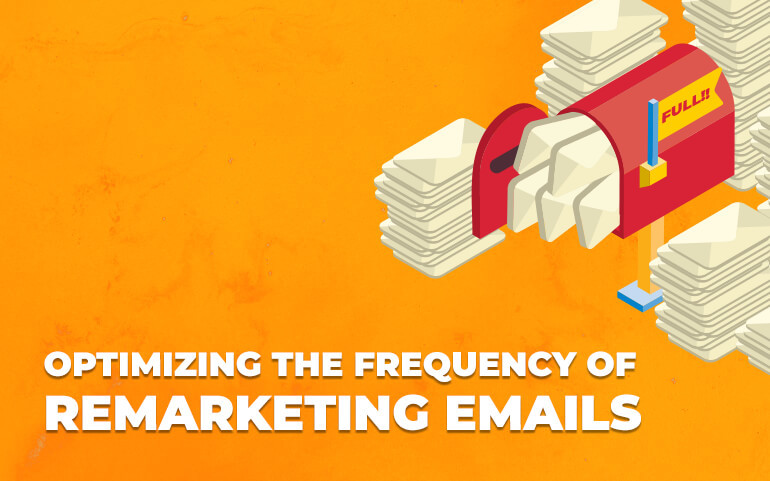Back in the day, email remarketing campaigns were known by a much more aggressive name: email blasts. Such campaigns suffered from poor public perception and high unsubscribe rates. Think about it – would you really want to have your email blasted? The nature and frequency of these remarketing emails were much different.
Today’s email remarketing campaigns are generally thought of more favorably. They utilize personalization to demonstrate relevance to customer interests.
Many factors contribute to an email being opened, such as sender names and subject lines. However, we often overlook frequency when thinking about campaign efficacy. The more emails you send, the lower your open rate goes.
Even if you have beautifully designed visuals and outstanding copy, the success of an email still depends on the respondent opening the message. If the email isn’t opened, your company’s efforts have gone to waste.
To ensure optimal open rates, and ultimately, conversions, we’ve leveraged the research behind methodical, well-planned remarketing email frequency to help you find the right balance.
What is a “Normal” Remarketing Email Frequency?
One of the challenging aspects of determining remarketing email frequency is that there is no cookie cutter solution. According to the Direct Marketing Association, 35% of businesses send only one or two marketing emails per month; 19% send only one per month, and 9% send more than six per month. With so much variance, it can seem difficult to determine your ideal send rate. As a general rule however, smaller companies should send fewer emails than larger companies.
Obviously, the goal of remarketing emails is to engage customers, and sending emails on a regular basis is a great way to do it. However, data shows that consumers, even those who signed up to receive marketing emails, strongly dislike being emailed too frequently.
According to Business2Community, 69% of their users unsubscribe after receiving “too many” emails. That being said, one of the most important things to consider in your email remarketing campaigns is why you are emailing your customers. Are you sending newsletters? Abandonment reminders/incentives? Advertising a sale? Promoting new inventory? All of these are legitimate reasons to send a remarketing email, however, frequency needs to be carefully considered.
The Economics of Email Frequency
One way to understand ideal frequency is to think in terms of economics. Assuming that someone has signed up for a company’s emails, this constitutes a demand. It’s a company’s job to supply a certain amount of them.
The frequency of remarketing emails is a classic example of a risk/reward ratio. For each message a company sends, the odds of engaging a customer go up. However, at a certain point, the frequency will reach a state of diminishing returns, as unsubscribe requests increase, therefore lowering conversions.
A company must send exactly enough emails to maximize new conversions while minimizing the number of unsubscribe requests.
Best Practices for Email Frequency
Although the exact frequency of remarketing emails will vary by company, there are some “rules of thumb” to help guide this sort of decision making. None of these are written in stone and can be adjusted until a company finds what works for them.
Newsletters + New Arrivals
In general, a company should send no more than one newsletter per month. The people on your email list obviously want to be up to date, but like a relative who recently discovered Facebook, oversharing can quickly become a nuisance.
Similarly, new inventory announcements are best kept to once or twice a month except in the case of extremely important announcements.
Sales
Informing users of a sale is a great way to land customers you may have missed the first time around, but the sale must be big enough to make it worth contacting your consumers.
For instance, announcing that a small category of merchandise is now 5% off is unlikely to sway someone who did not purchase at full price. The incentive is not large enough to warrant such a notice. However, for sales with a greater scope and incentive, it absolutely makes sense to send several emails.
A frequently used model is: One message promoting the initial sale, one reminding users of the sale, and one towards the end of the sale.
Abandonment Messaging
Abandonment reminders are another great way to recover conversions. In general, these chains consist of between one and four messages, with three being about average. The odds of the successfully converting a recipient may be increased if the emails offer an incentive for purchase, such as a discount or free shipping.
Regardless of whether or not an incentive is used, expanding beyond four is likely to come across as pestering, and may drive a user to unsubscribe.
It’s All About Results
Determining effective remarketing email frequency is a vital part of any company’s email remarketing strategy. While finding the right balance requires some tweaking, the guidelines in this article are an excellent place to start.
When your email strategy works, the rewards can be huge: higher engagements, greater conversion rates, and higher order values.
Looking for More Ways to Increase Your Conversions?
Check out UpSellit’s 27 Attributes of an Effective Email. This in-depth guide covers the ins-and-outs of crafting the perfect remarketing email. It’s a great resource and it’s totally free! Download it today and start writing awesome emails that convert.
